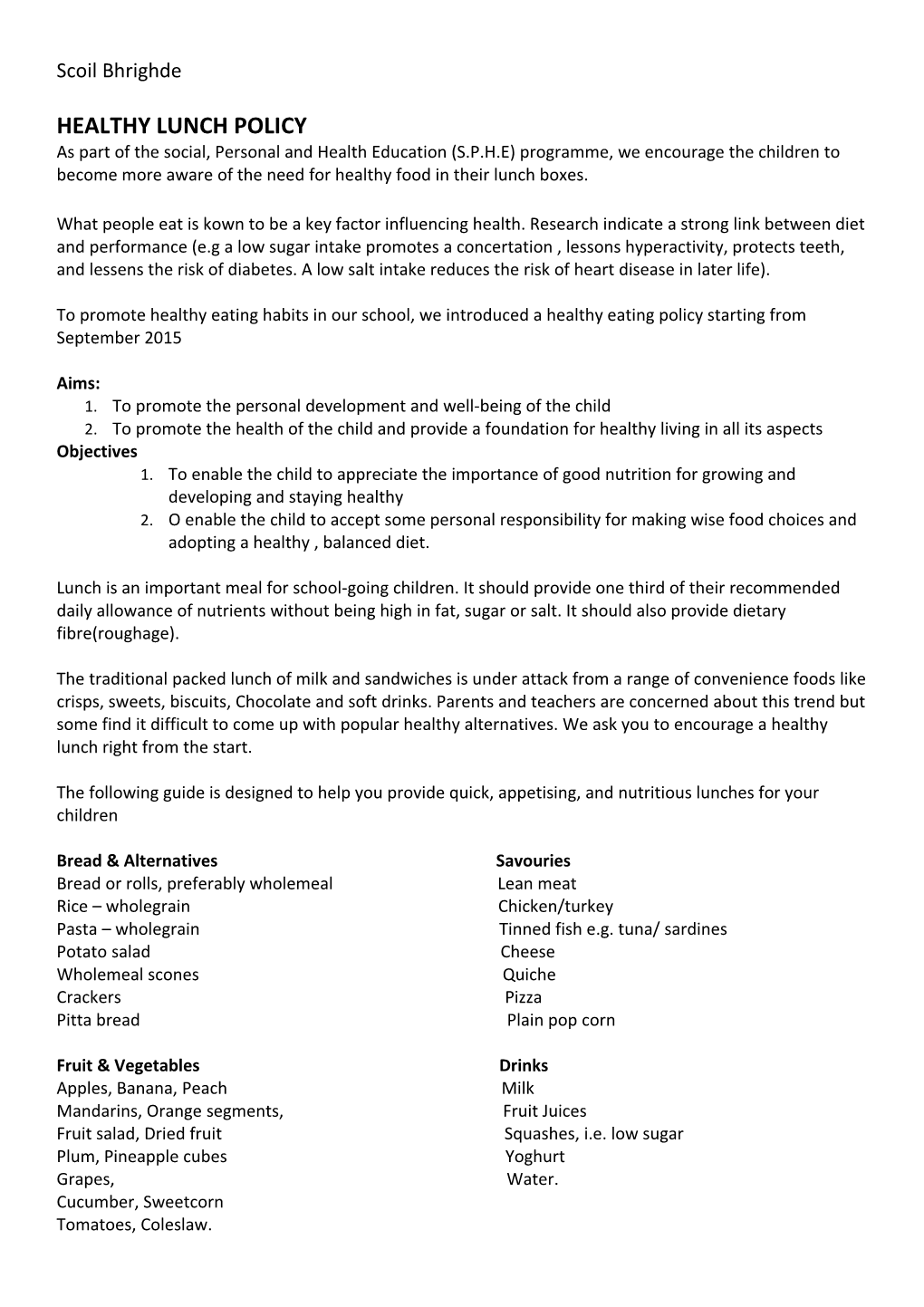ScoilBhrighde
HEALTHY LUNCH POLICY
As part of the social, Personal and Health Education (S.P.H.E) programme, we encourage the children to become more aware of the need for healthy food in their lunch boxes.
What people eat is kown to be a key factor influencing health. Research indicate a strong link between diet and performance (e.g a low sugar intake promotes a concertation , lessons hyperactivity, protects teeth, and lessens the risk of diabetes. A low salt intake reduces the risk of heart disease in later life).
To promote healthy eating habits in our school, we introduced a healthy eating policy starting from September 2015
Aims:
- To promote the personal development and well-being of the child
- To promote the health of the child and provide a foundation for healthy living in all its aspects
Objectives
- To enable the child to appreciate the importance of good nutrition for growing and developing and staying healthy
- O enable the child to accept some personal responsibility for making wise food choices and adopting a healthy , balanced diet.
Lunch is an important meal for school-going children. It should provide one third of their recommended daily allowance of nutrients without being high in fat, sugar or salt. It should also provide dietary fibre(roughage).
The traditional packed lunch of milk and sandwiches is under attack from a range of convenience foods like crisps, sweets, biscuits, Chocolate and soft drinks. Parents and teachers are concerned about this trend but some find it difficult to come up with popular healthy alternatives. We ask you to encourage a healthy lunch right from the start.
The following guide is designed to help you provide quick, appetising, and nutritious lunches for your children
Bread & Alternatives Savouries
Bread or rolls, preferably wholemeal Lean meat
Rice – wholegrain Chicken/turkey
Pasta – wholegrain Tinned fish e.g. tuna/ sardines
Potato salad Cheese
Wholemeal scones Quiche
Crackers Pizza
Pitta bread Plain pop corn
Fruit & Vegetables Drinks
Apples, Banana, Peach Milk
Mandarins, Orange segments, Fruit Juices
Fruit salad, Dried fruit Squashes, i.e. low sugar
Plum, Pineapple cubes Yoghurt
Grapes, Water.
Cucumber, Sweetcorn
Tomatoes, Coleslaw.
A word about Milk
Growing children should get approximately one pint of milk a day, or its equivalent as cheese, yoghurt or milk pudding. This ensures that they get enough calcium, which is essential for healthy bones and teeth. If a child does not drink a glass of milk at lunch, encourage him to have a carton ot yoghurt or a small helping of cheese instead.
We ask that children do not bring the following to school:
Snacks known to be high in sugar, saturated fat, salt, additives and preservatives, including the following:
- Crisps (including crisps style snaks)
- Fizzy drinks (including fizzy fruit- flavoured water, juices, etc)
- Sweets
- Chocolate biscuits/bars
- Cereal bars
- Chewing gum
- Fruit winders
- Popcorn sweet or salted
- Chewing gum
A very simple approach to healthy eating is to use the food Pyramid:
Fats
Sugar Sparingly
Sweets etc.
Meat/Fish 2 portions per day
Peas/ Beans
Milk, Cheese 3 + Portions per day
Yoghurt
Fruit & Vegetables 4 + portions per day
Bread, Cereals & Potatoes 6 + portions per day
